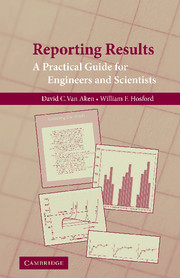Book contents
- Frontmatter
- Contents
- Preface
- REPORTING RESULTS
- 1 Elements of Technical Writing
- 2 Technical Papers
- 3 Technical Letters
- 4 Oral Presentations
- 5 Presentation of Technical Data
- 6 Statistical Analysis of Experimental Data
- 7 Resumé Writing
- Appendix I COMMON ERRORS IN WRITING
- Appendix II PUNCTUATION
- Appendix III COMMON WORD ERRORS
- Appendix IV INTERNATIONAL SYSTEM OF PREFIXES AND UNITS
- Appendix V THE GREEK ALPHABET AND TYPICAL USES
- Appendix VI STRAIGHT-LINE PLOTS FOR SOME MATHEMATICAL FUNCTIONS
- References
- Index
Preface
Published online by Cambridge University Press: 05 September 2012
- Frontmatter
- Contents
- Preface
- REPORTING RESULTS
- 1 Elements of Technical Writing
- 2 Technical Papers
- 3 Technical Letters
- 4 Oral Presentations
- 5 Presentation of Technical Data
- 6 Statistical Analysis of Experimental Data
- 7 Resumé Writing
- Appendix I COMMON ERRORS IN WRITING
- Appendix II PUNCTUATION
- Appendix III COMMON WORD ERRORS
- Appendix IV INTERNATIONAL SYSTEM OF PREFIXES AND UNITS
- Appendix V THE GREEK ALPHABET AND TYPICAL USES
- Appendix VI STRAIGHT-LINE PLOTS FOR SOME MATHEMATICAL FUNCTIONS
- References
- Index
Summary
This brief guide was written for science and engineering students and professionals to help them communicate technical information clearly, accurately, and effectively. The focus is on the most common communication forms and the most common issues that arise in classroom and professional practice.
Freshman chemistry or physics will be the introduction to technical report writing for many college students. The format for writing these laboratory reports is most often specified by the instructor. This guide will be useful in developing a good technical writing style and for preparing tables and figures for those reports. Upper-level courses often use the same formatting as is required for submission to technical journals or for technical report writing, which is the focus of this book. Graduate students and professionals encounter many of the same problems in technical communication. Good communication skills are required in all forms of technical writing and presentation. This book is designed to help the reader develop effective communication skills and to be a reference on stylistic and grammar issues. Unlike most texts on writing style, this book also treats oral presentations, graphing, and analysis of data.
The authors' intention is to give the reader the basics of technical communication in the first chapter and then to treat in detail the various forms of technical communication. The structure of the book is as follows:
Chapter 1 provides a general discussion of technical communication.
Chapter 2 covers writing technical reports and archival papers.
Chapter 3 discusses writing letter reports, which are common in industry.
Chapter 4 gives general guidelines for oral presentations.
[…]
- Type
- Chapter
- Information
- Reporting ResultsA Practical Guide for Engineers and Scientists, pp. vii - xPublisher: Cambridge University PressPrint publication year: 2008



